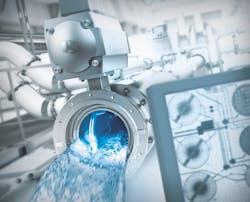How to Outfit Ball Valves & Actuators
About the author: Andrew Feeney is product specialist, process automation, for Festo Corp. Feeney can be reached at [email protected].
Ball valves are a common choice in water systems because they are inexpensive and have a high temperature and pressure tolerance. The valve works by rotating a metal sphere (the ball) with an empty cylinder (the bore) drilled through the center. By rotating the ball, the bore is either in line with the pipe and allows the media to flow through it, or the bore is perpendicular to the pipe and blocks the flow through it. The valve also may sit in an intermediate position, which offers some flow control.
The bore sometimes is referred to as a cavity, where chemicals, water or gases can sit inside the valve until it is rotated. If these substances can harden or change over time while trapped in this cavity, then a different type of valve may be necessary.
Size & Media Considerations
The size of the pipe often is the first specification to consider. Ball valves commonly are used for applications ranging from ½ to 2 in. When an application requires a valve larger than 2 in., butterfly valves may be a more cost-effective choice. Another consideration is the media that will be traveling through the valve. Chemical compatibility with the valve material is important to consider when selecting a valve for a process application. Stainless steel often is a great choice because it has high corrosion resistance to many chemicals. The downside to stainless steel is the added cost for the material. Brass may be a cost-effective alternative and should be considered if chemical compatibility is not an issue. Other common considerations for media properties include state, viscosity, adhesiveness and temperature. When ordering ball valves, look for compatibility with each of these properties.
Types of Ball Valves
There are many types of ball valves, including plastic and metal, which vary by the type of disassembly possible. Some ball valves are available in one-, two- or three-piece configurations. A three-piece ball valve commonly is used if the valve needs to be easily disassembled and thoroughly checked. Three-piece valves are most common in process applications where cleanliness is a high priority. A one- or two-piece valve typically is more economical than a three-piece valve.
Once the type of ball valve is selected, the method of opening and closing it must be chosen. Either a manual handle or pneumatic actuator will be selected to operate the valve. Leading ball valve suppliers provide online or phone assistance to identify and pair the appropriate ball valve to the actuator. There are several key considerations, including whether the media is hazardous or sticky. Two types of actuators are available. The single-acting
component features a spring return to the home position; the double-acting actuator requires pneumatic pressure to open and close the valve.
Sizing the Actuator
The size of a pneumatic actuator depends on the air pressure available at the facility, especially if it needs to overcome the compression of the spring in a single-acting actuator. When an actuator is single-acting, there is a different torque value at the beginning and end of actuation than when it is actuated only by air. This two-stage operation opens via air pressure and closes using built-in springs. It is important to ensure that the spring is strong enough to overcome the torque of the ball valve at all points of operation. If the ball valve requires a lower torque than the air and spring provide, then the actuator is a suitable match for the valve. If an electric actuator is considered, ensure proper torque, power requirements and mounting interface compatibility.
Typically, a rack and pinion actuator will be paired with a ball valve because it provides consistent torque while rotating. Another common design for actuators is the scotch yoke. This actuator design commonly is paired with butterfly valves because they have higher torque requirements at the beginning and the end of their operation, compared with the middle.
Special Applications/Positioner
Most ball valves are either open or closed with limited, if any, impact on flow. There are, however, ball valves with different types of ports, if controlling the flow also is desired. Two common types of ball valve bores are the “V” port ball valve and a narrow parallel slit. These types of valves commonly are outfitted with an actuator and a positioner. The positioner controls the angle at which the valve is rotated, thus regulating flow. Special considerations are taken when a valve will be used with harsh chemicals or sticky media. This aspect is described as a safety factor and increases in cases like this.
NAMUR
The NAMUR interface is an industry standard for the mounting pattern and pneumatic connections that can be found on a device. A NAMUR valve is an electrically controlled valve that attaches to the side of an actuator. An electric signal from a programmable logic controller or relay is used to activate the valve and allows air to flow to the actuator, which in turn opens or closes the ball valve.
Ball valves are the workhorses of the process industry. When paired with the optimal actuator and specified to be compatible with the media, these valves should provide years of sound operation.
Download: Here
